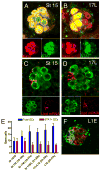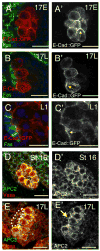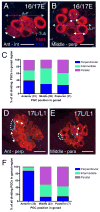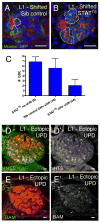Jak-STAT regulation of male germline stem cell establishment during Drosophila embryogenesis
- PMID: 19643104
- PMCID: PMC2777977
- DOI: 10.1016/j.ydbio.2009.07.031
Jak-STAT regulation of male germline stem cell establishment during Drosophila embryogenesis
Abstract
Germline stem cells (GSCs) in Drosophila are descendants of primordial germ cells (PGCs) specified during embryogenesis. The precise timing of GSC establishment in the testis has not been determined, nor is it known whether mechanisms that control GSC maintenance in the adult are involved in GSC establishment. Here, we determine that PGCs in the developing male gonad first become GSCs at the embryo to larval transition. This coincides with formation of the embryonic hub; the critical signaling center that regulates adult GSC behavior within the stem cell microenvironment (niche). We find that the Jak-STAT signaling pathway is activated in a subset of PGCs that associate with the newly-formed embryonic hub. These PGCs express GSC markers and function like GSCs, while PGCs that do not associate with the hub begin to differentiate. In the absence of Jak-STAT activation, PGCs adjacent to the hub fail to exhibit the characteristics of GSCs, while ectopic activation of the Jak-STAT pathway prevents differentiation. These findings show that stem cell formation is closely linked to development of the stem cell niche, and suggest that Jak-STAT signaling is required for initial establishment of the GSC population in developing testes.
Figures






Similar articles
-
Jak-STAT regulation of cyst stem cell development in the Drosophila testis.Dev Biol. 2012 Dec 1;372(1):5-16. doi: 10.1016/j.ydbio.2012.09.009. Epub 2012 Sep 23. Dev Biol. 2012. PMID: 23010510 Free PMC article.
-
Competitiveness for the niche and mutual dependence of the germline and somatic stem cells in the Drosophila testis are regulated by the JAK/STAT signaling.J Cell Physiol. 2010 May;223(2):500-10. doi: 10.1002/jcp.22073. J Cell Physiol. 2010. PMID: 20143337 Free PMC article.
-
The JAK/STAT pathway positively regulates DPP signaling in the Drosophila germline stem cell niche.J Cell Biol. 2008 Feb 25;180(4):721-8. doi: 10.1083/jcb.200711022. Epub 2008 Feb 18. J Cell Biol. 2008. PMID: 18283115 Free PMC article.
-
The development of germline stem cells in Drosophila.Methods Mol Biol. 2008;450:3-26. doi: 10.1007/978-1-60327-214-8_1. Methods Mol Biol. 2008. PMID: 18370048 Free PMC article. Review.
-
Hedgehog in the Drosophila testis niche: what does it do there?Protein Cell. 2013 Sep;4(9):650-5. doi: 10.1007/s13238-013-3040-y. Epub 2013 Jun 26. Protein Cell. 2013. PMID: 23807635 Free PMC article. Review.
Cited by
-
The 3D genome landscape: Diverse chromosomal interactions and their functional implications.Front Cell Dev Biol. 2022 Aug 11;10:968145. doi: 10.3389/fcell.2022.968145. eCollection 2022. Front Cell Dev Biol. 2022. PMID: 36036013 Free PMC article. Review.
-
Polar cell fate stimulates Wolbachia intracellular growth.Development. 2018 Mar 23;145(6):dev158097. doi: 10.1242/dev.158097. Development. 2018. PMID: 29467241 Free PMC article.
-
Sonication-facilitated immunofluorescence staining of late-stage embryonic and larval Drosophila tissues in situ.J Vis Exp. 2014 Aug 14;(90):e51528. doi: 10.3791/51528. J Vis Exp. 2014. PMID: 25146311 Free PMC article.
-
Gilgamesh is required for the maintenance of germline stem cells in Drosophila testis.Sci Rep. 2017 Jul 18;7(1):5737. doi: 10.1038/s41598-017-05975-w. Sci Rep. 2017. PMID: 28720768 Free PMC article.
-
An actomyosin network organizes niche morphology and responds to feedback from recruited stem cells.Curr Biol. 2024 Sep 9;34(17):3917-3930.e6. doi: 10.1016/j.cub.2024.07.041. Epub 2024 Aug 12. Curr Biol. 2024. PMID: 39137785
References
-
- Aboim AN. Developpement embryonnaire et post-embryonnaire des gonades normales et agametiques de Drosophila melanogaster. Revue Suisse de Zoologie. 1945;52:53–154.
-
- Arbouzova NI, Zeidler MP. JAK/STAT signalling in Drosophila: insights into conserved regulatory and cellular functions. Development. 2006;133:2605–16. - PubMed
-
- Asaoka M, Lin H. Germline stem cells in the Drosophila ovary descend from pole cells in the anterior region of the embryonic gonad. Development. 2004;131:5079–89. - PubMed
-
- Baksa K, Parke T, Dobens LL, Dearolf CR. The Drosophila STAT protein, stat92E, regulates follicle cell differentiation during oogenesis. Developmental Biology. 2002;243:166–175. - PubMed
-
- Bellve AR. Introduction: the male germ cell; origin, migration, proliferation and differentiation. Semin Cell Dev Biol. 1998;9:379–91. - PubMed
Publication types
MeSH terms
Substances
Grants and funding
LinkOut - more resources
Full Text Sources
Molecular Biology Databases
Research Materials

